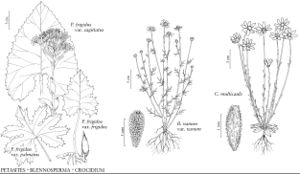Difference between revisions of "Crocidium multicaule"
Fl. Bor.-Amer. 1: 335, plate 118. 1834.
Treatment appears in FNA Volume 20. Treatment on page 641.
FNA>Volume Importer |
FNA>Volume Importer |
||
| Line 46: | Line 46: | ||
|publication year=1834 | |publication year=1834 | ||
|special status= | |special status= | ||
| − | |source xml=https://jpend@bitbucket.org/aafc-mbb/fna-data-curation.git/src/ | + | |source xml=https://jpend@bitbucket.org/aafc-mbb/fna-data-curation.git/src/8f726806613d60c220dc4493de13607dd3150896/coarse_grained_fna_xml/V19-20-21/V20_1446.xml |
|tribe=Asteraceae tribe Senecioneae | |tribe=Asteraceae tribe Senecioneae | ||
|genus=Crocidium | |genus=Crocidium | ||
Revision as of 16:20, 18 September 2019
Leaf blades: basal 10–25+ × 3–8(–12+) mm, entire or toothed; cauline 3–12 × 1–4 mm, mostly entire. Involucres 3–5(–7+) mm. Ray florets: corolla tubes 1–1.5 mm, laminae oblong to elliptic, 3–6(–10) mm. Disc florets: corolla tubes 0.7–1.5 mm, throats 0.5–1.1 mm, lobes 0.5–0.9 mm. Cypselae 1.5–2.5 mm; pappi 2–4 mm. 2n = 18.
Phenology: Flowering Feb–Jun.
Habitat: Grassy, mossy, or bare, often disturbed, sometimes wet sites in chaparral, oak forests, conifer forests, and sagebrush scrub
Elevation: 90–1500 m
Distribution

B.C., Calif., Idaho, Oreg., Wash.
Discussion
Selected References
None.
Lower Taxa
None.
